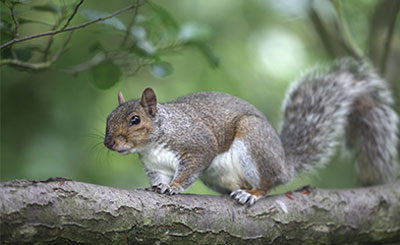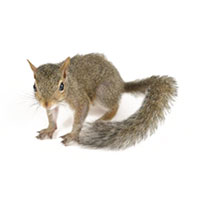





Squirrel Diet
Generally, squirrels feed on tree bark, seeds, walnuts, acorns, other kinds of nuts, and the various fungi that are found in the forest region. They are an opportunist in searching for food, and therefore can adapt to a wide variety of habitats. Squirrels change their diet based on the current season and eat whatever is available. They feed on buds of hardwood trees in spring, winged seeds of maple in summer, along with some other berries and other wild fruits. During autumn, their diet comprises mostly of hard nuts, hickory nuts, beechnuts, pine seeds, and butternuts. During this time of year, they are also working hard to stock up their supplies for winter.

Squirrel Habitat
Often seen scampering from branch to branch, squirrels are seen in all kinds of environments, including parks, neighborhoods and wooded areas. The ideal habitat for a squirrel has an abundance of nut-producing trees and a diverse selection of other food sources available during different seasons. Gray squirrels live in two types of dwelling structures:
- Dens: Holes typically constructed in healthy, living trees. Sometimes, these tree cavities are used as nests for raising young.
- Nests: Densely packed masses of sticks and leaves. Nests are usually located high up in the forked branches of large trees.
Dens are preferred for over-wintering and for raising young, but with constant maintenance, nests are very weatherproof and sturdy. Looking for warmth during the coldest months of the year, squirrels are known for seeking shelter in human structures, including attics and exterior walls, using insulation as nesting material.
Squirrel Life Cycle
Gray squirrels breed in mid-December or early January and again in June if food is very abundant. Most females begin their reproductive life at one year old. Males usually are sexually mature by 11 months, but maturity can be delayed by as much as two years if the young males are around a dominant adult male. During the breeding season, noisy mating chases take place when one or more males pursue a female through the trees. When not breeding, the gray squirrel is solitary. Pregnancy lasts about 44 days with one to eight pups in each litter. The young are cared for by the mother and are weaned after they are two months old.
Only 25% of gray squirrels survive their first year. The survival rate remains quite low for the first two years of life. If a squirrel makes it past two years, it has a high survival rate for another four of five years. It is unlikely for a squirrel to live past 10 years due to the impact of disease and debilitation (tooth loss, cataracts, and parasites) slowing them down just enough to compromise their ability to survive. An average squirrel has an average life expectancy of three years.
Squirrel Diseases
The gray squirrel is a host to many diseases and parasites, including lice, worms, and ticks.
Squirrel Damages
Inhabit Structures
Squirrels generally inhabit wooded areas and nest in trees, but will frequently establish themselves in attics or garages, where they’ll store their food and take up shelter.
Home Damage
Yard Damage
Squirrels have been known to dig up garden beds and damage fruit-bearing trees and vegetable gardens.
Tree Damage
Squirrels will strip bark from trees and ornamental plants.
Noisy Behavior
Squirrels are noisy in their activities and will bite if you corner them.
Fire Hazard
If they are nesting in vents, the blockage may create a fire hazard.
Squirrel Prevention & Control
Squirrel Prevention
Like many pests, the most effective way to make your property less attractive to squirrels is to reduce access to the food, water, and shelter that the animals need. Prevention is the best way to discourage squirrels from taking up permanent residence in or around your property. Follow the recommendations below to minimize the chances of squirrels becoming a problem.
- Eliminate or control food sources like birdseed and pet food. If you want to get rid of them, make feeders squirrel-proof.
- Remove sources of human food. Garbage cans should have tight-fitting lids.
- Protect gardens with fences, wire, or electricity as deterrents.
- Seal any openings that may serve as points of entry like chimneys, foundation gaps, torn weather stripping, holes in roofs, or holes in siding. Before sealing, make sure no live animals are present.
- Trim tree branches that fall close to your home so they can’t jump to your roof.
- Remove any firewood stacked against your home.
Certain repellents and noise deterrents can limit squirrel activity in the short-term but typically lose effectiveness over time.
Squirrel Control
If you think squirrels are in your home, a specialist will work with you to confirm that the noises you hear are from squirrels. We then seek out gaps squirrels use to get in (which can create easy entry points for other pests). Expert squirrel removal is the next step, which requires the right timing and approach, especially if squirrels are nesting. For squirrels, Batzner uses live trapping baited with walnuts, hazelnuts, peanuts, sunflower seeds. After squirrels are removed, recommendations are made to prevent future problems.
If you’re having problems with squirrels around your home or business, contact a pest control professional for expert removal services.
Need help with Squirrels?
We'll call you! Leave your information below.





